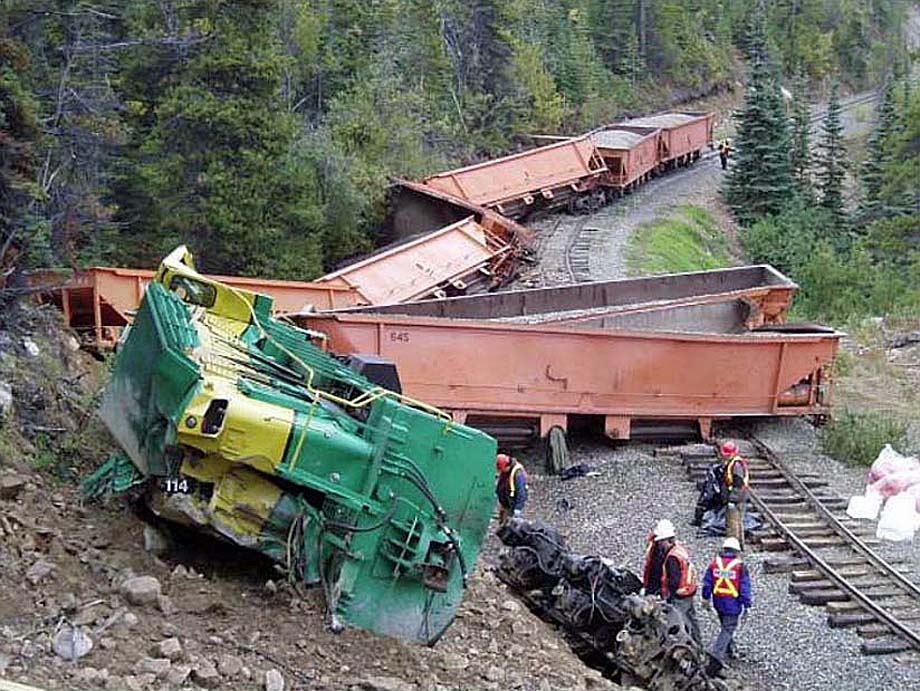Log Cabin Yukon - When Darryl Froese and Julie Cossette saw the train coming, they did what any sane person would do, they got off the tracks and waited for it to pass.
It never did.
The White Pass & Yukon Route diesel locomotive derailed, killing one man, and injuring three others.
Bruce Harder, 45, a White Pass heavy equipment operator, and well-known Carcross volunteer, was fatally injured.
Three other White Pass workers were also hurt in the crash.
"Bruce was just a wonderful man. His loss will be felt far beyond our White Pass family, and by many others, I'm sure," said White Pass president Gary Danielson.
Harder was the Carcross fire chief and head of search-and-rescue, said Danielson.
"He was very well known in his community and throughout the area. And his wife is the emergency medical dispatcher and first responder in Carcross. It was a very difficult situation. She was on site."
The train conductor, Lee "Toogie" Hartson Jr., from Skagway, was medevaced to hospital in Anchorage for surgery, and the engineer, Jeff Ruff, was taken to Whitehorse General Hospital, he said.
The other injured worker, heavy equipment operator Neil Plested from Carcross, was released from hospital Monday, he added.
The young couple that discovered the wreck had just spent 2.5 days backpacking the historic gold rush route.
Froese and Cossette were hiking along the White Pass & Yukon Route to Log Cabin, near the Alaska border.
There, they planned to catch a shuttle back to civilization.
Sunday morning, on the exit spur a few kilometres south of Bennett Lake, a German couple had joined them.
The foursome ambled along the tracks, against private property rules that are routinely disregarded by hikers departing the Chilkoot Trail.
It was about 12:40 when the group saw the eight-car train coming in the distance, winding its way along the narrow gauge track, said Froese.
"We were about four miles from Log Cabin. We got off the tracks to let the train go by," said Froese, who like Cossette, is a Whitehorse local.
They heard the train approach.
Then Froese heard a loud screeching from around a bend just ahead of them, about 200 metres down the track.
It only lasted a second or two.
They didn't hear a crash, but the train didn't come around the bend.
The hikers waited for a minute.
Then they investigated.
The first thing they saw as they rounded the corner was a weird cloud, they thought it was steam or dust.
They'd seen a plume coming from the diesel locomotive's smokestack.
But then they saw the orange car lying across the tracks at a perpendicular angle.
The hikers dropped their packs and jogged closer, finding the green and yellow White Pass engine on its side on an embankment.
Its undercarriage was torn away and diesel fuel was spraying from a pierced tank.
"It was just gushing diesel. I said, we're not staying here, it's way too dangerous, that thing could explode," said Froese.
Even if the wreck didn't explode, they would be covered in diesel if they got too close, and they weren't carrying gear to handle flammable liquids and burns, he said.
But the hikers knew at least one person must be trapped within the wreck.
In fact, there were four.
But the hikers didn't hear anybody respond as they called out, approaching the wreck as close as they dared.
"The electricity of the train was not shut off," said Cossette, who has certified wilderness first-aid training.
"It was still on."
They noted where the tracks had buckled and broken beneath the train.
But with a small cliff on one side of the wrecked engine, and diesel pooling on the other, they could only safely search for survivors on one side, said Froese.
They searched for five minutes, then decided to go for help.
The German man, being extremely fit, ran down the tracks towards Log Cabin, still wearing his pack, said Froese.
The others followed, their pace energized by the adrenaline of the crash scene.
It wasn't long, a few minutes said Froese, before three railroad technicians in a small car sped past on its way to the crash site.
The rescuers had already been notified of the crash.
White Pass trains are equipped with a handset that can send a distress signal with a few clicks, said Danielson.
"There's a way of notifying an emergency without speaking too many words, by a series of clicks on the radio," said Danielson on Tuesday.
One of the crew members was able to place the call, he said.
"He was very badly injured."
Danielson was still in a state of sad bewilderment while fielding phone calls from the company's Skagway offices two days after the crash happened.
But he was pleased with the speed of the emergency response to the crash site.
"That day, our roadmaster was going in to Lake Bennett on other business, and he was following the work train in a motorcar, and he heard the call and immediately moved forward as fast as he could.
"He was there, literally, within minutes of the accident."
Meanwhile, the White Pass dispatcher activated an emergency management plan.
The first group of technicians was followed by a team of paramedics, and another team of firefighters, even before three helicopters began to arrive.
The train had been loaded with gravel for use at the Bennett terminal.
Danielson wouldn't say if he thought the cause of the crash might be speed or too much weight on the rails.
"I really can't comment because I have no idea."
Investigators from the federal Transportation Safety Board (TSB) arrived at the crash site Monday, he said.
Transport Canada won't comment on an ongoing investigation, said spokesman John Cottreau.
"The investigators are starting with a clean slate, they don't have any preconceived ideas," Cottreau said Tuesday.
"They're going to take measurements, and photographs, and conduct interviews, and they're going to try and determine the causes and factors that led to the occurrence."
Such investigations normally take two days, he added.
White Pass operations into Bennett are shut down for the time being, until the wreck has been cleared and the track repaired.
Nothing like this has ever happened in White Pass's history, said Danielson.
There was an accidental fatality in 2000 during a maintenance job at one of the company shops in Skagway, but never a derailment causing death, he said.
In the transportation industry, crashes are expensive.
Clean up and repair cost a lot, and customer confidence is easily shaken.
White Pass could suffer loss of bookings for next year, when the company's expansion plans to run trains into Carcross are scheduled to begin for the first time in years.
But Danielson isn't worried about money right now.
"This has no effect on our present business. Where it has an effect is within our company, in our personnel. We all feel pretty shaken by the experience right now," he said.
Graeme McElheran.
Excerpts from the Transportation Safety Board Railway Investigation Report R06V0183 - 3 Sep 2006
On 3 Sep 2006, at about 13:00 Pacific daylight time, northbound White Pass & Yukon Route work train 114, comprising one locomotive and eight loaded ballast cars, ran uncontrolled down a steep grade and derailed the locomotive and the first six ballast cars at Mile 36.5 on the Canadian Subdivision. One person was fatally injured and three others sustained serious injuries. The six derailed ballast cars were destroyed.
At approximately 11:40, after the last car was loaded, the conductor and two heavy equipment operators entrained, and the four loaded ballast cars on the siding were switched back in. The crew performed a brake test, and the locomotive engineer instructed the conductor on the procedure for setting retainers. He requested that the conductor set one retainer in the high pressure position. The locomotive engineer released the automatic brake and the train departed. The conductor remained on the short-nose platform outside the locomotive because the three seats inside the cab were occupied. The short-nose end of the locomotive was coupled to the ballast cars, that is, the locomotive was to be run with its long hood forward.
At Mile 33.8, while travelling at about 15 mph on the descending 1.5 percent grade, the locomotive engineer reduced the throttle and made an automatic brake application of 18 pounds per square inch (psi). He brought the train to a controlled stop at Mile 34.2. The locomotive engineer asked that the conductor set the remaining retainers in the high pressure position. The conductor detrained and set the retainers on the remaining two similarly equipped ballast cars.
The locomotive engineer released the independent and automatic brakes and the train departed. At approximately Mile 34.5, where the grade starts to descend at about 1.5 percent before briefly levelling off at Mile 34.9, the locomotive engineer placed the throttle in the idle position, applied the independent brake, and made another 18 psi automatic brake application. The work train then slowed down to less than 10 mph, therefore, the locomotive engineer released the automatic brake to avoid stalling. He then controlled the train with the independent brake.
The train then began descending the 3.3 percent grade at Mile 35.0, and the speed increased to about 12 mph. The locomotive engineer had waited as long as possible, more than 30 seconds, to recharge the train before making a 20 psi automatic brake application just as the train crested the grade. However, the train's speed continued to increase. The locomotive engineer increased the independent brake effort in an attempt to control the speed. At about Mile 35.3, while the train was travelling at approximately 18 mph, the locomotive engineer increased the automatic brake application to just short of a full service brake application. At that time, smoke was observed coming from the locomotive wheels.
At about Mile 35.5, the train speed was approximately 20 mph and the locomotive engineer, realizing that the train was a runaway, placed the automatic brake into emergency and made an emergency radio broadcast. However, because there was no direct radio link, neither the dispatcher nor the roadmaster heard the call. The train continued to accelerate.
As the train was negotiating the 16 degree, left-hand curve at Mile 36.5, the conductor jumped to the east and landed in a small stream. The train then derailed to the outside of the curve, the east side (see Photo above). The locomotive engineer and the two heavy equipment operators were trapped inside the cab.
One of the two heavy equipment operators was conscious, but the lower part of his body was buried in rock and debris. While digging himself out, he uncovered the locomotive engineer and revived him. He then used a nearby portable radio to inform the roadmaster of the accident. The roadmaster proceeded to the derailment site and found both of the heavy equipment operators and the locomotive engineer trapped in the cab. He then found the conductor incapacitated in a small stream below the right-of-way and pulled him from the water. The dispatcher was called and emergency assistance was requested.
The conductor had sustained serious injuries and was airlifted by helicopter to hospital. After being revived, the locomotive engineer freed himself from the locomotive cab. The heavy equipment operator who placed the radio call to the roadmaster was freed by the first responders at approximately 18:00. Both men had sustained serious injuries and were transported to hospital. The second heavy equipment operator had sustained fatal injuries and was extricated from the nose of the locomotive by approximately 21:00.
(likely no image with original article)
(usually because it's been seen before)
(the image is altered or fake)
provisions in Section 29 of the
Canadian Copyright Modernization Act.


